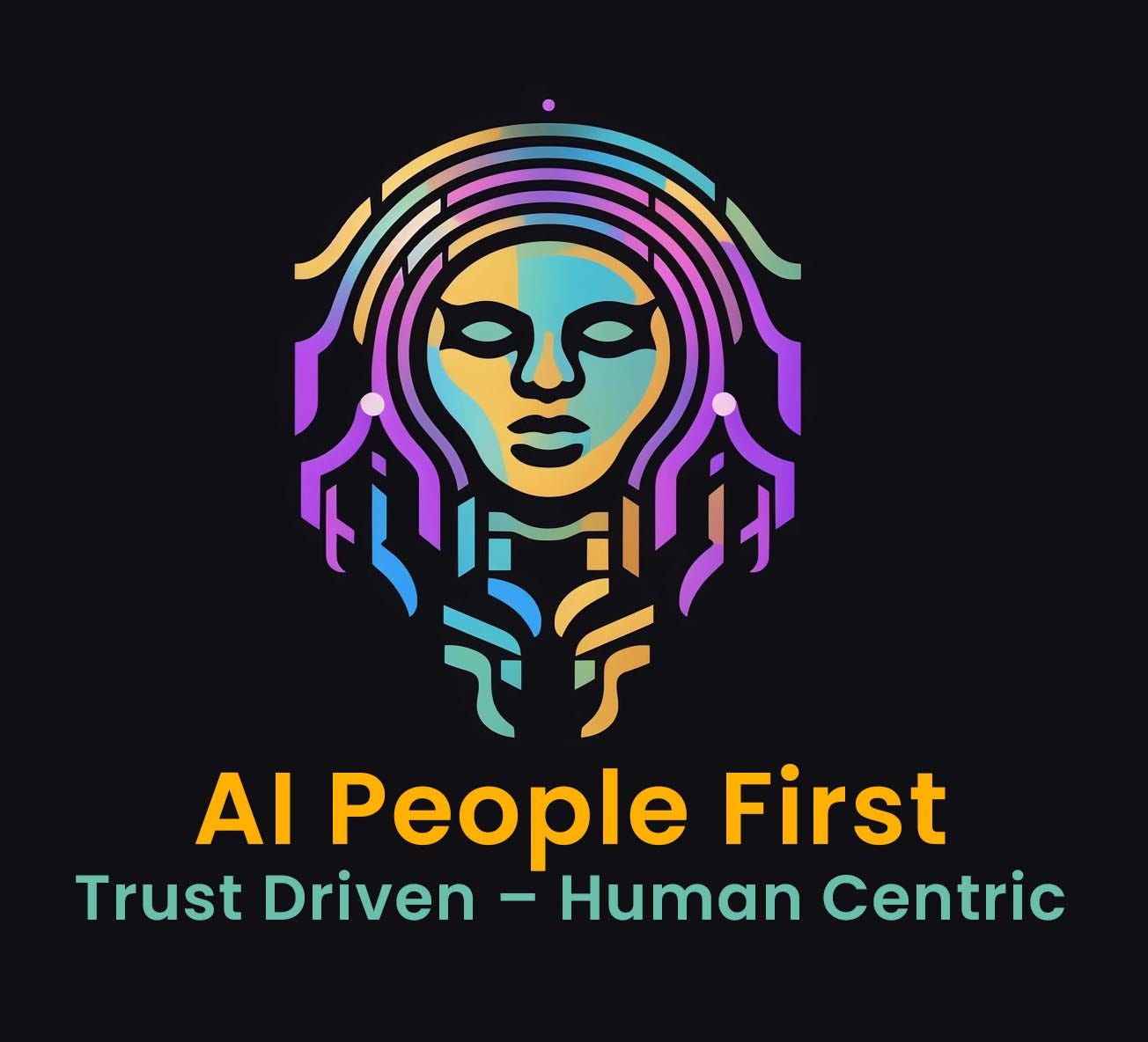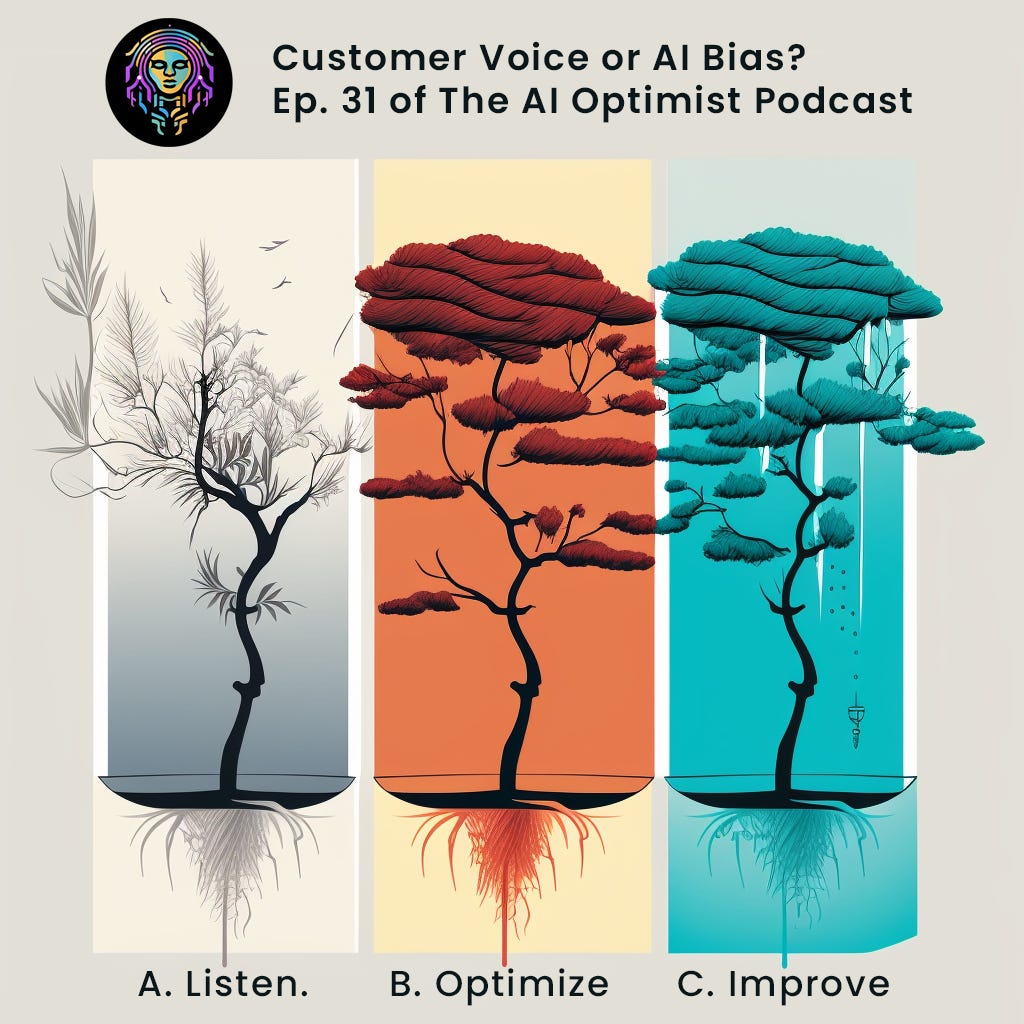Listen to Your Customers to Overcome AI Bias
The Fault Lies Not in our Customers but in Tone Deaf Elevator Pitches dripping from poor GenAI Prompts
Listen on Apple || Spotify || YouTube
Do you ever feel like your business messaging or website just isn't resonating with your target audience? You may be experiencing AI bias without even realizing it.
In this video, I explain how you can use customer voices from social media and other channels to create buyer personas and messaging that truly connects.
Here's what’s inside:
Why listening to real customer conversations is key before crafting messaging
How to use public social forums and discussions to build a customer collage
Tips for optimizing tone, visuals, and SEO with AI assistance
Setting up an improvement cadence every 30-90 days
Prompt chains over single prompts for better AI dialogues
Knowing your biases and reaching out to diverse customer profiles
The goal is to let YOUR customers guide your branding, not the other way around. Competitor obsession can lead you astray.
By truly understanding multiple buyer personas through an ongoing dialogue with real customers, you'll stand out with authenticity.
Subscribe and check out the video to reinforce putting AI and people first!
Overcoming algorithmic bias starts with human conversations.
Begin Listening -
00:00:00 Customer Voice of AI Bias intro
00:01:16 Energy Healing Keyword Start
00:02:28 Finding Your Customer's Voice with AI
00:03:03 A - Listen to your customer
00:05:22 VIEWSTATS YouTube Research
00:09:12 B. Optimize
00:13:22 Prompt chains
00:15:25 C. Improve every 30-90 days
00:17:04 Closing - Know your Bias
Brought to you by AI People First
Imagine a world where AI is not just an entity working in the background but is a tool that truly understands and respects human values.
A world where AI isn't a threat to our jobs but instead becomes our best collaborator, enhancing our skills and creativity.
It's not just about making AI smarter. It's about making AI work better for all of us.
It's about cherishing and preserving what makes us human even as we embark on this journey of a tech revolution.
This is our invitation to you – let's not just adapt to AI; let's shape it to adapt to us!
SCENARIO
Your business is beginning or needing to improve in a challenging economy. You look to GenAI to help craft a customer voice – literally the voice of the customer driven words, tone, and style for your brand.
AI startups listening, this is my long-developed process of being guided in design, business model, the value you deliver as a business, and what you add to the AI landscape.
Customer Voice / AI Bias
Listen to the customer first, before crafting messaging or website design
Use social media comments and discussions to create a "customer voice" collage
Take excerpts from public forums where permissible
Create 2-3 pages of customer comments
Optimize the customer voice content
Use ChatGPT to analyze website examples and make recommendations
Ask for feedback on tone, style, colors, words
Get SEO keyword guidance
Improve systematically every 30-90 days
Do SEO audit of your site using targeted keywords
Keep adding to customer voice from more sources
Reach out to customers directly via DM or other channels
Key Takeaways:
Break prompts into chains rather than just 1-2 prompts
Ongoing dialogue yields better results
Know your biases and blindspots
Differentiate and create multiple customer profiles
Competitor analysis less important than listening to own customers
Next Steps:
Gather more customer content across various channels
Create prompt chains tailored to website, messaging goals
Set 30 or 90 day reminders to re-evaluate strategy
Reach out to select customers for direct feedback
A. Listen to the Customer’s Voice – “Walk” with them.
B. 𝗢𝗽𝘁𝗶𝗺𝗶𝘇𝗲 – Follow the Feedback
C. Test and improve every 30-90 Days!
A. Listen to the Customer’s Voice – “Walk” with them
⬜ Check for patterns, trends, and keywords – obvious ones.
⬜ Work with AI to define their tone, style, learning styles, and feeling via social posts.
⬜ Create 3 Prompt Chains – a series of prompts for:
1. Tone,
2. 3-5 Pages of Customer Content (social discussions or related content) to use as a control,
3. ICP – Ideal Customer Profile prompt and also ChatGPT response for updating.
B. 𝗢𝗽𝘁𝗶𝗺𝗶𝘇𝗲 – Follow the Feedback
⬜ Take your blog post or social post or ad copy.
⬜ Use the Tone Prompts (and Prompt Chains for repeat questions) and apply to your content.
⬜ In a separate chat, analyze the 3-5 pages of customer content, then upload your copy and prompt it to rewrite in the style you uploaded first.
⬜ Use both of these Chats to develop ICPs with prompts – let it identify your ideal customers related to this copy, along with any additional information and spreadsheets you have to add for your customers.
C. Test and Improve every 30-90 Days
⬜ Add more sources for the Customer Voice – content, social, and keep evolving.
⬜ Keep testing on new content to see what updates will help you from a stale Customer Voice.
⬜ Develop 2-5 ICPs over a year if you haven’t already. Focus on the top 3 first and keep refining.
Listening to the Customer’s Voice – “Walk” with them
⬜ Check for patterns, trends, and keywords – obvious ones.
⬜ Work with AI to define their tone, style, learning styles, and feeling via social posts.
⬜ Create 3 Prompt Chains – a series of prompts for:
1. Tone,
2. 3-5 Pages of Customer Content (social discussions or related content) to use as a control,
3. ICP – Ideal Customer Profile prompt and also ChatGPT response for updating.
Don’t Prove Your Bias: The Balanced Data Approach
In this training, your point of view is bias. Instead of training your AI on a narrow dataset that represents just a sliver of your customer base, aim for a broader, more inclusive range.
Imagine training an AI to understand customer sentiment but only using data from a single demographic. You'd be missing out on the diversity of human experience, and your AI would too.
A diverse dataset translates to an AI that can understand and respond to a wider range of human experiences. That's good for customers and great for business.
Achieving this balance isn't easy. It requires diligence in data collection.
The "Colorblind" Strategy
The second approach involves intentionally ignoring variables like race, gender, or age when training your AI models. It's a bit like saying, "Let's not see color; let's just treat everyone the same."
The simplicity of this approach is appealing, especially for a quick fix. The drawbacks are serious. You risk turning a blind eye to customer issues that affect people differently, and that's not just bad ethics—it's also bad business.
Taking the time to curate a balanced and diverse data is smart. By treating it as such, you're better positioned to create an AI output that's equitable and in tune with the complex world it serves.
𝗢𝗽𝘁𝗶𝗺𝗶𝘇𝗲 – Follow the Feedback
⬜ Take your blog post or social post or ad copy.
⬜ Use the Tone Prompts (and Prompt Chains for repeat questions) and apply to your content.
⬜ In a separate chat, analyze the 3-5 pages of customer content, then upload your copy and prompt it to rewrite in the style you uploaded first.
⬜ Use both of these Chats to develop ICPs with prompts – let it identify your ideal customers related to this copy, along with any additional information and spreadsheets you have to add for your customers.
Step 1: Go Where the People Are
Think you know what your customers want? Easy there, bias lover.
Jump into social media, forums, and online communities where your customers hang out. Listen and learn.
Look at the books they read; review the 5-star reviews to know what they love, and the 1-star reviews to find out the critical part people missed.
Step 2: Follow the Feedback
Ignoring customer feedback is like neglecting the gas gauge in your car. Not smart.
Run polls, watch social discussions and videos, or even a quick DM to ask folks what they think about your brand or product.
Listen and don’t interrupt; the truth may hurt, and it’s also the key to finding their voice for your brand.
Use this approach as an ongoing dynamic between you and the audience; they change and you change.
Result: Collage the Voices
What Not to Do: Prove your right instead of listening to what the customers will show you.
Your old brand voice is comfy and often outdated as a flip phone.
The Right Move: Collect all the tidbits, phrases, and slang you’ve heard from customers to craft your brand’s voice.
Stop inventing pain points and witness how customers explain your brand. Or how they view your product/service in general if this is a startup.
It’s less about their pain and more about their lack of interest and attention.
Focus on public information and permission; it’s easy to do this in stealth and violate the trust and ethical principles behind good AI..
Test and Improve every 30-90 Days
⬜ Add more sources for the Customer Voice – content, social, and keep evolving.
⬜ Keep testing on new content to see what updates will help you from a stale Customer Voice.
⬜ Develop 2-5 ICPs over a year if you haven’t already. Focus on the top 3 first and keep refining.
A: Prototype That Voice
Create a prototype customer voice for your brand and test it in a small campaign or with a social group.
Start with 3-10 people; watch and listen to emerging patterns.
Finding their voice takes a little extra time. You are planting seeds.
B: Find your best voice and scale it out a bit.
You’re good, but you’re not that good. And it doesn’t matter (maybe to egos, no to customers).
Use that new voice in a broader setting and actively ask for positive and negative feedback.
C: Create Customer Voices with AI with the best learnings.
Be adaptable:
“My way or the highway” doesn’t work.
Use the feedback to refine your voice. Repetition is vital.
Systematize with AI to turn this into your Customer Voice. Run your copy through these learnings, and once you find the right path, create a separate Customer Voice to keep challenging and training your original findings.
Business today is a dynamic game, not a short-term dance. Play the long game.
Your Action Plan:
Social Media Recon: Dedicate weekly to listening and gathering phrases and opinions.
Quick Feedback: Use tools like Google Forms to create short surveys for direct feedback. Use social media to gauge interest and sentiment analysis (there are AI tools to do this!)
Voice Crafting: Spend a day creating your new brand voice based on your learning.
Social Group: Organize a small group or small campaign to test the new voice.
Broad Testing: Apply the voice to a more extensive campaign and ask for critiques.
Refine: Give another day or two to tweak based on the feedback.
Full Rollout: Update all your social media, website, and outreach to the new voice.
Your customer’s bias is the one that counts. It turns browsers into buyers and maybe even into die-hard brand advocates. Get out of your head and into their words and experience.
Wake Up and Smell the AI Bias – Because you help create it!
You might think, “Hey, it’s a machine. Machines don’t have prejudices.” Wrong. Machines learn from humans, and we’re far from perfect.
If you train ChatGPT on just a bunch of tech bro blogs, don’t be surprised when it starts sounding like one.
Be aware that some have tested out and biased AI against race, gender, and physical location. Think things through before taking action to ensure you do the right thing.
Quick Fix: Use data from all walks of life. Think of it like a potluck dinner; everyone brings something to the table.
1. Check AI’s Homework:
You ask AI to figure out what customers would love. This way, people get what they want!
2. Let AI Learn from Everyone
You wouldn’t color a picture with just one crayon? Same thing with AI.
Make sure it learns from all kinds of people to give everyone what they like. Nobody feels left out, and sales grow!
3. Teach AI to Play Fair
AI can pick favorites without meaning to. Teach it to be fair so that everyone gets a chance to enjoy what you’re offering. Fair play keeps customers happy and coming back!
4. Ask for a Second Opinion
If you’re stuck on a complex game level, you’d ask a friend for help. If you’re unsure your AI is being fair, ask people for their thoughts. They might see something you didn’t, which will improve your business.
5. Keep an Eye on Your AI
Let’s say you are building a house. You’d check the foundation plans with an architect to make sure it doesn’t fall over.
Same with AI—keep an eye on it to ensure it stays on track. People’s ideas of what’s good can change, so your AI should, too.
Make sure your AI is the best it can be for your business while ensuring everyone gets the proper treatment.
Quick Nuggets of Wisdom:
Bias Happens: Just ’cause it’s a machine doesn’t mean it’s off the hook for bias.
Variety is Spice: Different voices and perspectives make your AI better.
Be the Good Cop: Ethical checks and balances aren’t just for the government; your AI needs it, too.
Stay on Your Toes: Watch your AI like a toddler. You never know when it might scribble on the walls.
Honesty Rules: Keep it 100 with your customers. Trust is the new currency.
ChatGPT or any other AI isn’t developing biases independently but learning from us. We’re the teachers here.





















